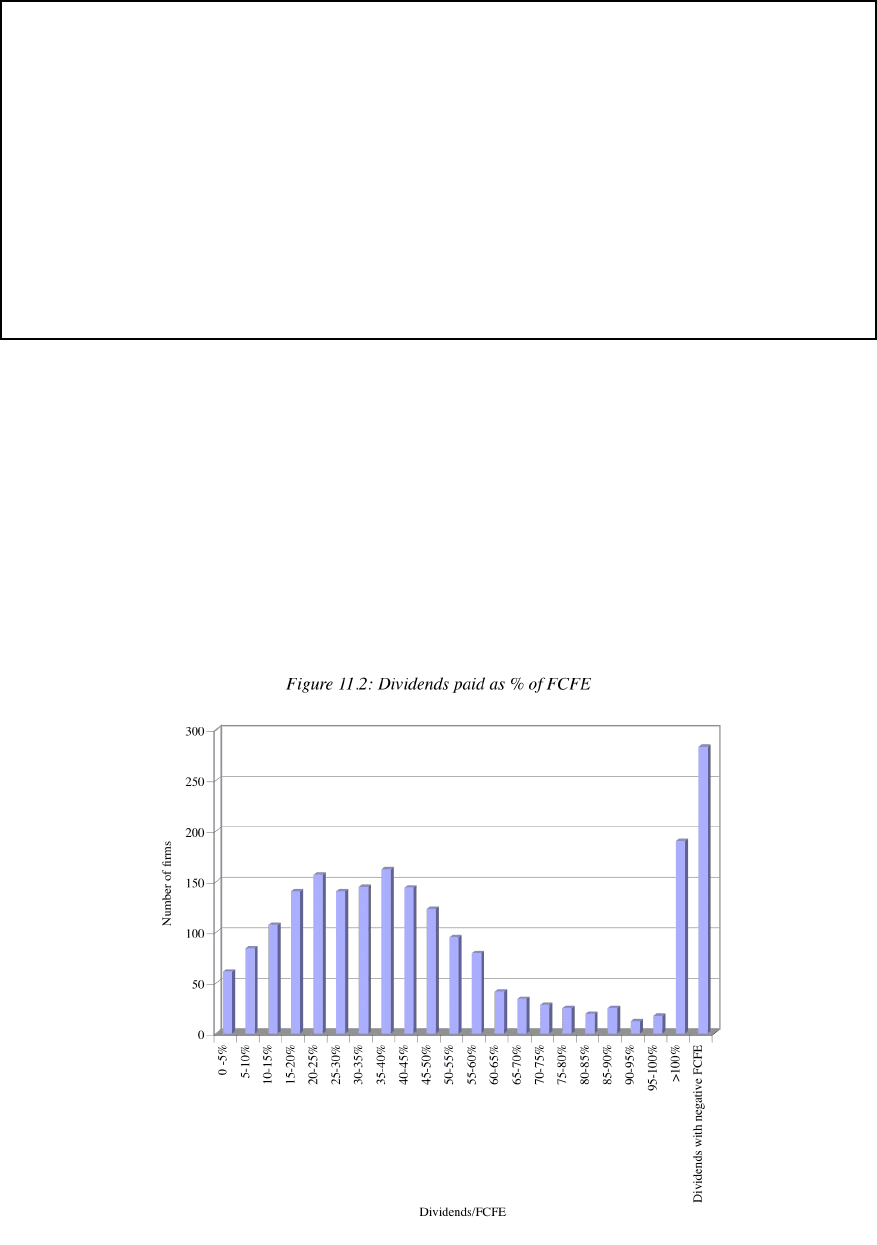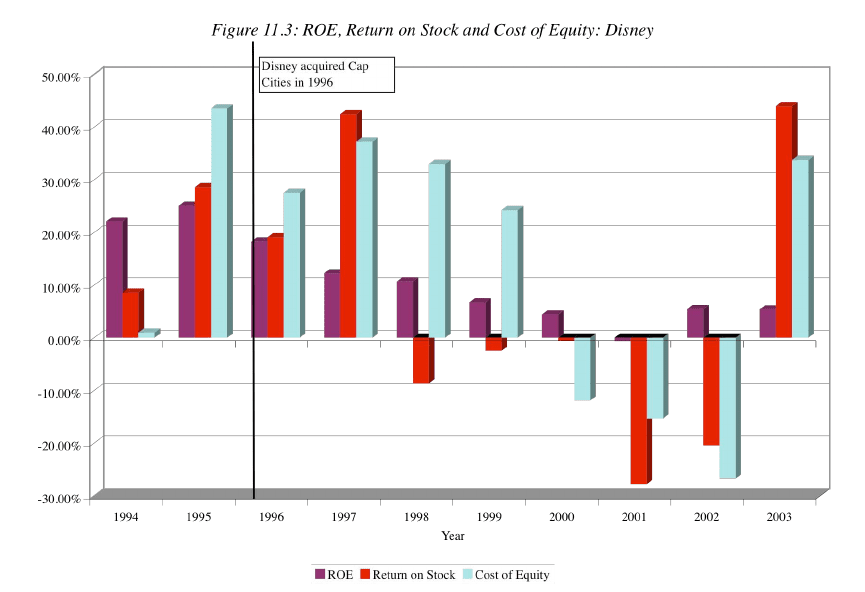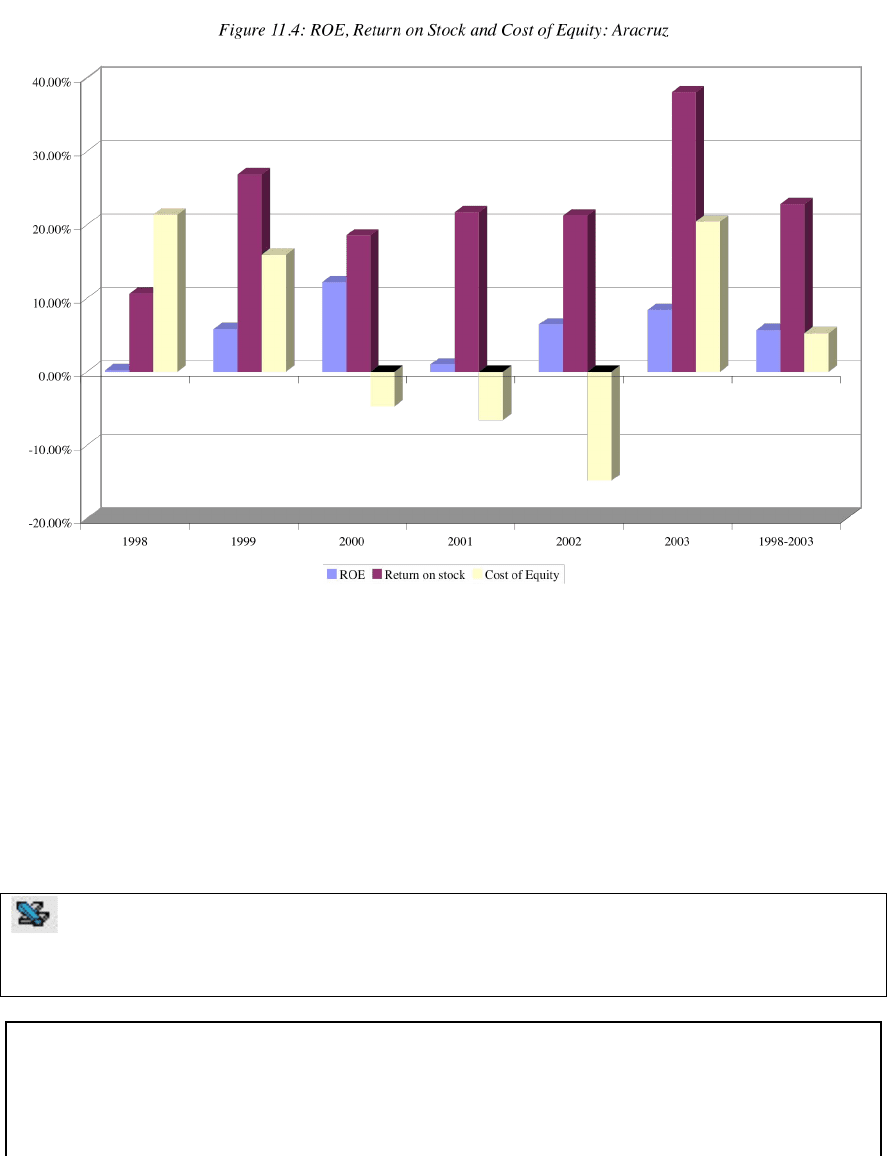Damodaran A. Applied corporate finance
Подождите немного. Документ загружается.


21
21
In 2003, Microsoft had free cash flows to equity of roughly $ 9 billion, paid no dividends
and bought back no stock. Where would you expect to see the difference of $ 9 billion
show up in Microsoft’s financials?
a. It will be invested in new projects
b. It will be in retained earnings, increasing the book value of equity
c. It will increase the cash balance of the company
d. None of the above
Explain.
Evidence on Dividends and FCFE
We can observe the tendency of firms to pay out less to stockholders than they
have available in free cash flows to equity by examining cash returned to stockholders
paid as a percentage of free cash flow to equity. In 2003, for instance, the median
dividend to free cash flow to equity ratio across dividend paying firms listed in the
United States was 60%. Figure 11.2 shows the distribution of cash returned as a percent
of FCFE across all dividend-paying firms.
Source: Value Line, 2003

22
22
A percentage less than 100% means that the firm is paying out less in dividends than it
has available in free cash flows and that it is generating surplus cash. For those firms that
did not make net debt payments (debt payments in excess of new debt issues) during the
period, this cash surplus appears as an increase in the cash balance. A percentage greater
than 100% indicates that the firm is paying out more in dividends than it has available in
cash flow. These firms have to finance these dividend payments either out of existing
cash balances or by making new stock and debt issues. Note that there are almost 300
firms in this period that paid dividends even though they had negative free cashflows to
equity. These firms will have to come up with enough funds, either from existing cash
balances or new stock issues, to cover both the dividends and the cash deficit.
This spreadsheet allows you to estimate the free cash flows to equity for a firm over
a period for up to 10 years and compare it to dividends paid.
Step 2: Assessing Project Quality
The alternative to returning cash to stockholders is reinvestment. Consequently, a
firm’s investment opportunities influence its dividend policy. Other things remaining
equal, a firm with better projects typically has more flexibility in setting dividend policy
and defending it against stockholder pressure for higher dividends. But how do we define
a good project?
According to our analysis of investment decisions, a good project is one that earns
at least the hurdle rate, which is the cost of equity, if cash flows are estimated on an
equity basis, or the cost of capital if cash flows are measured on a pre-debt basis. In
theory, we could estimate the expected cash flows on every project available to the firm
and calculate the internal rates of return or net present value of each project to evaluate
project quality. There are several practical problems with this, however. First, we have to
be able to obtain the detailed cash flow estimates and hurdle rates for all available
projects, which can daunting if the firm has dozens or even hundreds of projects. The
second problem is that, even if these cash flows are available for existing projects, they
will not be available for future projects.

23
23
As an alternative approach to measuring project quality, we can use one or more
of the three measures we developed in chapter 5 to evaluate a firm’s current project
portfolio:
• Cash Flow Return on Investment (CFROI), which measures the real internal rate of
return on existing investments, based upon expected cash flows and the remaining life
of the investments, and compares it to the real cost of capital
• Accounting Return differentials, where we compare the accounting return on equity
to the cost of equity and the accounting return on capital to the cost of capital.
• Economic value Added, which measures the excess return earned on capital invested
in existing investments, and can be computed either on an equity or capital basis.
We did note the limitations of each of these approaches in chapter 5, but they still provide
a measure of the quality of a firm’s existing investments.
Using past project returns as a measure of future project quality can result in
errors if a firm is making a transition from one stage in its growth cycle to the next, or if
it is in the process of restructuring. In such situations, it is entirely possible that the
expected returns on new projects will differ from past project returns. Consequently, it
may be worthwhile scrutinizing past returns for trends that may carry over into the future.
The average return on equity or capital for a firm will not reveal these trends very well,
because they are slow to reflect the effects of new projects, especially for large firms. An
alternative accounting return measure, which better captures year to year shifts, is the
marginal return on equity or capital, which is defined as follows:
Marginal Return on Equity
t
=
Net Income
t
! Net Income
t- 1
Book Value of Equity
t
- Book Value of Equity
t -1
Marginal Return on Capital =
EBIT(1 ! t)
t
! EBIT(1 ! t)
t-1
Book Value of Capital
t
- Book Value of Capital
t -1
Although the marginal return on equity (capital) and the average return on equity
(capital) will move in the same direction, the marginal returns typically change much
more than do the average returns, the difference being a function of the size of the firm.
These marginal returns can be used to compute the quality of the new projects added on
by the firm.

24
24
The alternative to using accounting returns to measure the quality of a firm’s
projects is to look at how well or badly a firm’s stock has done in financial markets. In
chapter 4, we compared the returns earned by a stock to the returns earned on the market,
after adjusting for risk. The risk-adjusted excess return that we estimated becomes a
measure of whether a stock has under- or outperformed the market. A positive excess
return would then be viewed as an indication that a firm has done better than expected,
while a negative excess return would indicate that a firm has done worse than anticipated.
Finally, accounting income and stock returns may vary year to year, not only
because of changes in project quality, but also because of fluctuations in the business
cycles and interest rates. Consequently, the comparisons between returns and hurdle rates
should be made over long enough periods, say five to ten years, to average out these other
effects.
Illustration 11.4: Evaluating Project Quality at Disney and Aracruz
In illustration 5.9, we examined the quality of existing investments at Disney and
Aracruz, using both accounting returns and economic value added. In the following
analysis, we examine both accounting and market measures of return at Disney and
Aracruz over the most recent time period, and compare them to the appropriate hurdle
rates to evaluate the quality of the projects taken at each firm during the period. We begin
with an analysis of Disney’s accounting return on equity, the return from holding the
stock, and the required return (given the beta and market performance during each year
7
)
from 1994 to 2003 as shown in Figure 11.3.
7
For instance, to estimate the expected return in 1998, we use the following:
Expected Return in 1998 = Riskfree rate at beginning of 1998 + Beta (Return on Market in 1998 – Riskfree
Rate at the beginning of 1998)
An average beta of 1.20 was used over the entire period for Disney.

25
25
As you can see, the verdict is not favorable to Disney, especially after the acquisition of
Capital Cities in 1996. The return on equity for the firm, which exceeded 20% in the two
years prior to the acquisition, plummeted in the years after to single digits. Accounting
rules can be blamed partially for the decline immediately after the acquisition because the
book value of equity at Disney jumped when it bought ABC. However, the continuing
decline in return on equity in 1998 and 1998 cannot be attributed to the book value write
and neither can the poor stock price performance between 1998 and 2001. It is clear that
any promised synergy in this merger has not materialized over the following seven years.
While there are individual years in which Disney project returns and stock returns exceed
the required return, the average return on equity over the entire period is 7.50%, which is
lower than the required rate of return of 14.62%. The average annual return from holding
Disney stock is 8.27%, which is also lower than the required return. Based upon the
company’s performance over the last few years, that there is little to suggest that
Disney’s managers can be trusted with cash.

26
26
Repeating this analysis for Aracruz for the 1998-2003 time period yields different
results. Figure 11.4 summarizes returns on equity, returns on the stock, and the required
return at the firm for each year between 1998 and 2003.
During this period, Aracruz earned an average return on equity of 5.68%, barely in excess
of its cost of equity of 5.27% but an investor in its stock would have seen an average
annual return of 22.84% over the same period. , Stockholders may be willing, at this
stage, to accept the firm’s contention that its projects are delivering sufficient returns, but
a key question will how much these returns are dependent upon the price of paper/pulp
holding up in future years. Looking at Aracruz’s history, it is quite clear that much of the
volatility in returns from year to year can be attributed to commodity price variation.
dividends.xls: This spreadsheet allows you to estimate the average return on equity
and cost of equity for a firm for a period of up to 10 years.
11.4. ☞: Historical, Average and Projected Returns on Capital
You have been asked to judge the quality of the projects available at Super Meats, a meat
processing company. It has earned an average return on capital of 10% over the last 5

27
27
years, but its marginal return on capital last year was 14%. The industry average return
on capital is 12%, and it is expected that Super Meats will earn this return on its projects
over the next 5 years. If the cost of capital is 12.5%, which of the following conclusions
would you draw about Super Meat’s projects
a. It invested in good projects over the last 5 years
b. It invested in good projects last year
c. It can expect to invest in good projects over the next 5 years
In terms of setting dividend policy, which of these conclusions matter the most?
In Practice: Dealing with Accounting Returns
Accounting rates of return, such as return on equity and capital, are subject to abuse
and manipulation. For instance, decisions on how to account for acquisitions (purchase or
pooling), choice of depreciation methods (accelerated versus straight line), and whether
to expense or capitalize an item (research and development) can all affect reported
income and book value. In addition, in any specific year, the return on equity and capital
can be biased upwards or downwards depending upon whether the firm had an unusually
good or bad year. To estimate a fairer measure of returns on existing projects, we would
recommend the following:
1. Normalize the income, before computing returns on equity or capital. For Aracruz, in
the analysis above, using the average income over the last 3 years, instead of the
depressed income in 1996 provides returns on equity or capital that are much closer to
the required returns.
2. Back out the effects of cosmetic earnings effects caused by accounting decisions,
such as the one on pooling versus purchase. This is precisely why we should consider
Disney’s income prior to the amortization of the Capital Cities acquisition in
computing returns on equity and capital.
3. If there are operating expenses designed to create future growth, rather than current
income, capitalize those expenses and treat them as part of book value, while
computing operating income, prior to those expenses. This is what we did with
Bookscape, when we capitalized operating leases and treated them as part of the

28
28
capital base, and looked at earnings before interest, taxes and operating leases in
computing return on capital.
Step 3: Evaluating Dividend Policy
Once we have measured a firm’s capacity to pay dividends and assessed its
project quality, we can decide whether the firm should continue its existing policy of
returning cash to stockholders, return more cash or return less. The assessment will
depend upon how much of the free cash flow to equity is returned to stockholders each
period, and on how good the firm’s project opportunities are. There are four possible
scenarios:
• A firm may have good projects and may be paying out more (in dividends and stock
buybacks) than its free cash flow to equity: In this case, the firm is losing value in two
ways. First, by paying too much in dividends, it is creating a cash shortfall that has to
be met by issuing more securities. Second, the cash shortfall often creates capital
rationing constraints; as a result, the firm may reject good projects it otherwise would
have taken.
• A firm may have good projects and may be paying out less than its free cash flow to
equity as a dividend. While it will accumulate cash as a consequence, the firm can
legitimately argue that it will have good projects in the future in which it can invest
the cash, though investors may wonder why it did not take the projects in the current
period.
• A firm may have poor projects and may be paying out less than its free cash flow to
equity as a dividend. This firm will also accumulate cash, but it will find itself under
pressure from stockholders to distribute the cash, because of their concern that the
cash will be used to finance poor projects.
• A firm may have poor projects and may be paying out more than its free cash flow to
equity as a dividend. This firm first has to deal with its poor project choices, possibly
by cutting back on those investments that make returns below the hurdle rate. Since
the reduced capital expenditure will increase the free cash flow to equity, this may
take care of the dividend problem. If it does not, the firm will have to cut dividends as
well.

29
29
Figure 11.5 illustrates the possible combinations of cash payout and project quality.
ROE - Cost of Equity
Cash Returned < FCFE
Cash Returned > FCFE
Good Projects
Poor Projects
Flexibility to
accumulate
cash
Cut payout
Invest in Projects
Increase payout
Reduce Investment
Cut payout
Reduce Investment
Figure 11.5: Analyzing Dividend Policy
Aracruz
Microsoft
Disney
In this matrix, Aracruz, with its superior (albeit barely) project returns and its history of
paying out more in dividends than it has available in free cash flows to equity falls in the
quadrant where cutting dividends and redirecting the cash to projects seems to make the
most sense. Disney, on the other hand, which pays less in dividends than it has available
in free cash flows to equity and has a recent history of poor project returns, clearly will
come under pressure to return more cash to its stockholders.
Note, though, that the pressure to pay dividends comes from the lack of trust in
Disney’s management rather than any greed on the part of stockholders. For a contrast,
consider Microsoft, which had $11.175 billion in free cashflows to equity inn 2003 and
returned only $857 million in dividends. The company’s high return on equity (>25%)
and superior stock price performance earned it the flexibility to pay out far less in cash
than it generated, with little protest from stockholders.

30
30
While we might obtain estimates of return on equity and free cash flow to equity
by looking at past data, the entire analysis should be forward looking. The objective is
not to estimate return on equity on past projects, but to forecast expected returns on future
investments. Only to the degree that past information is useful in making these forecasts
is it an integral part of the analysis.
Consequences of Payout not matching FCFE
The consequences of the cash payout to stockholders not matching the free cash
flows to equity can vary depending upon the quality of a firm’s projects. In this section,
we examine the consequences of paying out too little or too much for firms with good
projects and for firms with bad projects. We also look at how managers in these firms
may justify their payout policy, and how stockholders are likely to react to the
justification.
A. Poor Projects and Low Payout
There are firms that invest in poor projects and accumulate cash by not returning
the cash they have available to stockholders. We discuss stockholder reaction and
management response to the dividend policy.
Consequences of Low Payout
When a firm pays out less than it can afford to in dividends, it accumulates cash.
If a firm does not have good projects in which to invest this cash, it faces several
possibilities: In the most benign case, the cash accumulates in the firm and is invested in
financial assets. Assuming that these financial assets are fairly priced, the investments are
zero net present value projects and should not negatively affect firm value. There is the
possibility, however, that the firm may find itself the target of an acquisition, financed in
part by its large holdings of liquid assets.
In the more damaging scenario, as the cash in the firm accumulates, the managers
may be tempted to invest in projects that do not meet their hurdle rates, either to reduce
the likelihood of a takeover or to earn higher returns than they would on financial assets.
8
8
This is especially likely if the cash is invested in treasury bills or other low-risk low-return investments.
On the surface, it may seem better for the firm to take on risky projects that earn, say 7%, than invest in
T.Bills and make 3%, though this clearly does not make sense after adjusting for the risk.
